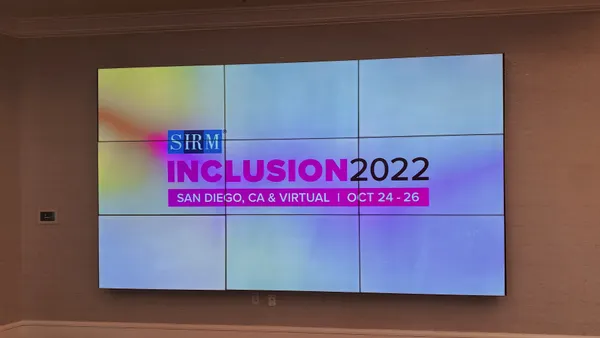HR teams know recruiting is important to diversity and inclusion efforts. So how are employers supposed to evaluate the changes they make to the recruiting process to improve D&I?
That question formed the basis of a recent HR Dive interview with Steven Bartel, CEO of outbound recruiting technology firm Gem, and Nick Bushak, Gem's chief technology officer and president. The company said it works to help employers determine precisely where specific groups of candidates withdraw or are dismissed from the recruiting process.
The aim, according to Bartel and Bushak, is to help employers understand what changes they can make to ensure more diverse slates of candidates. In a Q&A with HR Dive, the two described their views on artificial intelligence in recruiting, leadership buy-in for D&I initiatives and common trouble spots in recruiting.
Editor's note: This interview has been edited for clarity and brevity
HR DIVE: How do you track candidates moving through Gem's solution? Is it something they opt into as part of the process?
STEVEN BARTEL: Wherever possible, we're using self-reported data. But when self-reported data isn't available, especially at the top of the funnel [when] they're not actually considered candidates yet, in that world we'll have a predictive algorithm that tries to understand an estimate [of] race, ethnicity and gender. The important thing to note, though, is we're never assigning that to an individual person. We're always showing that data in aggregate across a broader talent pool. We're never using that data to identify a single person.
What this allows companies to do is get a directional sense of their talent pool and the representation as it passes through the funnel.
So it's more of an analysis instead of direct tracking?
BARTEL: It's a predictive algorithm that identifies the mix of a talent pool by gender, race and ethnicity, and it's using a lot of different factors that go into that algorithm to classify and predict the overall percentage of that group of talent.
NICK BUSHAK: That's what gives you the, sort of, percentage breakdowns. We don't, for example, allow you to go in and see how certain people were classified. But the most important thing is directional guidance for these numbers; that way, a company can see at a high level how they're doing.
I was interested to see the amount of roles that you're measuring — specific job titles and breaking it down that way. I have to imagine that requires a lot of consistency on the part of the employer. Is that something you emphasize to clients?
BUSHAK: One of the outcomes from our analytics product is that, in some cases, the underlying data and the data cleanliness does need to be looked at, because this is the first time some recruiting teams are seeing data recorded. That's sort of a natural outcome that happens in a lot of cases where people will start using our analytics product to get visibility into their recruiting pipelines. They might notice some data is off, and pretty naturally after that, a lot of companies will go in and change their processes around to make sure they're getting clean data so that way they actually have visibility.
You mentioned that a Gem client once noticed that underrepresented candidates were exiting the interview process because they weren't seeing interviewers who looked like them. A common concern for employers is that without true inclusion, these diversity recruiting efforts don't amount to much. Do you talk with employers about the work they need to do on the other side of the process?
BARTEL: Absolutely. Our product doesn't yet cover that aspect but, in general, diversity is so core to Gem. We value it internally, we live and breathe it every single day, and you can't have diversity without inclusion and equity. And so, because our product doesn't address it yet today, we actually do a lot of content around that and how you can build a more inclusive and equitable culture. We don't just limit our thought leadership content to the areas that Gem can solve, because DEI is so important. We're oftentimes learning and teaching best practices across the entire stack, all the way from source to hire to retention.
Are there common spots where candidates exit? Or spots where a lot of employers are seeing this type of result?
BARTEL: The most consistent thing I see is when companies start to dig into the data, they realize that at the top of the funnel, they've just never looked at the breakdown of their gender, race and ethnicity by candidate source. And what they realize is the traditional sources of hiring talent, whether that be inbound referrals or any of the traditional sources, are inherently less diverse. What they realize is that if they really want to change the mix-up of their recruiting pipeline, they need to double down on affirmative action efforts. That's where engaging passive talent comes in. That's the one consistent thing we see across the industry and so many customers.
But in terms of debugging their pipeline and identifying where folks are falling off, whether it's because they're taking themselves out of the process or maybe the process itself is flawed and not leading to equitable interviews, that is oftentimes pretty company-specific, role-specific and department-specific. It depends a lot on the interview loop, what types of questions we're asking and what types of prep we're enabling our candidates with. For that, there's no silver bullet. You just have to dive into the data and figure out where in the funnel folks are falling off at different rates, and then dive even deeper, look at things like rejection reasons, to see reasons for why.
A lot of the recruiting conversation around D&I has been about sourcing. How do conversations around sourcing impact your approach?
BARTEL: Something really did shift over this past year when it comes to starting to engage with talent in different [geographies] and regions. With a lot of companies moving toward hybrid or remote first, suddenly they have this big opportunity in front of them: they can engage with talent anywhere in the world. That's actually a huge thing for diversity, inclusion and equity efforts because traditionally the folks [who] are located in the Bay Area itself — that demographic is inherently less diverse, too.
"The most consistent thing I see is when companies start to dig into the data ... what they realize is the traditional sources of hiring talent, whether that be inbound referrals or any of the traditional sources, are inherently less diverse."

Steven Bartel
CEO, Gem
And so by opening up these other talent pools in other [geographies], that's been one of the huge drivers and places where companies are now sourcing and finding underrepresented talent basically for the first time, because they're realizing now they can hire anywhere.
Hybrid and remote work is interesting from a D&I standpoint. A 2020 Pew Research Center study found most full- or part-time workers could not do their jobs from home, and Black and Hispanic workers were less likely than Asian and White workers to say that they could do their jobs from home. Is that something you've thought about?
BARTEL: Tech companies in general are placing a much bigger emphasis on diversity, equity and inclusion. That's been a huge shift. It's been happening for the past five to 10 years but really accelerated over this past year. And what we're seeing is that they're using the remote and hybrid new future of work as an opportunity to source more diverse talent, not less. What I'm seeing from all of our customers is [that] they're embracing that as a way to accelerate their diversity, inclusion and equity efforts.
BUSHAK: Yeah, and I think a lot of these actions, to actually make a difference, it's companies looking at some of this data for the first time that is forcing these conversations. More and more companies are starting to brainstorm: "How do we move the needle for our specific situation and our specific company?" They're starting to do analyses in terms of why people are dropping out: "Is it a top-of-funnel issue; are people falling out of the process for some reason; is it the remote or hybrid situation that is causing us to lose out on people?" All of those factors are kind of talked about, we think, [for the first time] because there's now hard data to back it up and it starts a lot of really interesting conversations. It's been cool to see companies actually thinking really hard about this, and not just in a localized place anymore. It's the executives all brainstorming together.
AI in recruiting is a broad subject. There's a big conversation about the benefits and drawbacks. When it comes to the role of AI in recruiting, what are your thoughts on some of the pitfalls, and what are you doing at Gem to make sure your algorithm is being used responsibly?
BARTEL: The places where companies run into challenges with AI [are where] you're deploying it to assess whether a candidate is a good fit or not. And the reason why that can be really dangerous is because the algorithms themselves can be biased based on all of the training data, which itself is biased.
Gem doesn't do any of that. What we're doing is helping identify in aggregate the mix of your pipeline so you can identify where the gaps are and where the opportunities are to improve things. We feel really good about that use case, and we don't think there's really any moral or business risk at all to companies. Really, it 100% just helps them improve their processes. Whereas, you start to run into trouble when you start to try to throw AI at evaluating folks.
BUSHAK: And you've probably heard about the Amazon example, where they did that internally and then turned it off. I agree, as AI gets added to more and more of the recruiting process it's definitely something to be careful about. I mean, we thought pretty deeply about diversity analytics and we've made a bunch of products centered around making sure everything's only in aggregate to make sure we don't run into any issues there. It's definitely something that needs to be looked at very carefully, and we've made a lot of effort to do that.
BARTEL: To Nick's point, we have all these guardrails in the product so that a hiring manager can't go in and necessarily identify an individual and make a decision based on that. That's why the aggregate piece is so important.
BUSHAK: Yeah, and there's documentation around how to use the aggregate information and all of that. Overall, I really do believe that technology can make a big difference as we've seen with a lot of our customers and our Diversity Analytics product. But we're all responsible to be really thoughtful in terms of the new technology that's built out because this is really important.
HR leaders have spoken in the past year about the need for leadership backing to accomplish D&I initiatives. For your clients, how much of the willingness to address D&I comes from leadership, and how difficult has it been for your clients to get leadership on board?
BARTEL: It has to come from the top, from the executive team, because if there's not executive buy-in, you can't enact that kind of organizational shift. The amazing thing that we saw over this past year is that that started to happen naturally. And it was already happening for some of the early-adopter, innovative companies when it comes to D&I. This year, that shifted from innovators to mainstream, and largely because employees were demanding it. With everything going on in the world, employees spoke up and said "hey, we really care about this." That shift has been amazing to see.
It used to be [that] one or two years ago, that would be something we would have to coach our buyer on: how do you get executive alignment for all of these D&I efforts. But these days, that conversation is so much easier because it's already there.
BUSHAK: Yeah, I do suspect that, while I agree with Steve on a lot of it [that] there does need to be this executive buy-in to really make a difference from a diversity standpoint, I do believe that there is still a trend of HR having a bigger say at companies […] I just think that's the way things are trending. I think there's a few reasons for that. One is that, when you think about it, companies aren't about how many factories [they] own anymore, it's about the people that [they] hire and the people that [they] retain. I think a lot of executives are realizing that shift. To become a great company, you need to hire the best talent and you need to retain the best talent.
The other thing that's starting to happen is HR leaders are becoming more data-driven in a few areas. Whereas in the past some conversations were anecdotal, now HR leaders have access to a lot of data and analytics. And that's, in a lot of cases, a language that the C-suite speaks. We've seen with a number of our customers that HR leaders are able to go to the C-suite with data to support some change that they want to make within the company. That data talks, and as HR leaders start to improve the data analytics they have access to, the data cleanliness, it makes it a lot easier for them to go to the C-suite.














